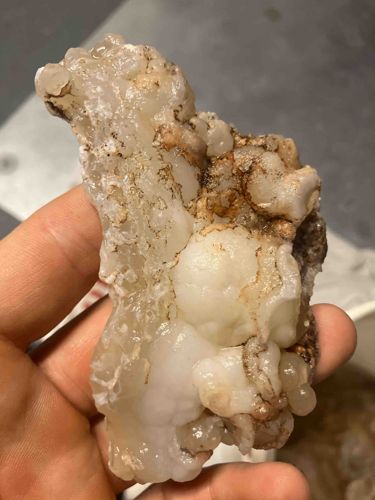
Raw Botryoidal Mineral Specimen
This is a raw, unpolished mineral specimen, likely a form of chalcedony or opal based on its waxy to vitreous luster and botryoidal (grape-like) formations. The specimen is irregular in shape and appears hand-held in the image, suggesting a size of a few inches in length. It exhibits a dominant opaque to translucent milky white color with significant areas displaying a creamy to light brown hue, particularly within the crevices and on some raised surfaces. These darker areas might be inclusions of iron oxides or other minerals, or possibly staining from the matrix in which it was found. The texture is highly uneven, with smooth, rounded surfaces alternating with rougher, granular areas and some small crystalline structures visible. There are no discernible manufacturer's marks, signatures, or stamps, consistent with a natural mineral specimen. The condition appears to be as-found, with no evidence of polishing, cutting, or artificial enhancements. The natural variations in color and texture are inherent to the material. Without further testing, determining the precise geological source and age is difficult, but it is a natural geological formation.
AI-Generated Appraisal Disclaimer
Estimated Value
$20-40
Basic Information
Category
Mineral Specimen
Appraised On
November 28, 2025
Estimated Value
$20-40
Item Description
This is a raw, unpolished mineral specimen, likely a form of chalcedony or opal based on its waxy to vitreous luster and botryoidal (grape-like) formations. The specimen is irregular in shape and appears hand-held in the image, suggesting a size of a few inches in length. It exhibits a dominant opaque to translucent milky white color with significant areas displaying a creamy to light brown hue, particularly within the crevices and on some raised surfaces. These darker areas might be inclusions of iron oxides or other minerals, or possibly staining from the matrix in which it was found. The texture is highly uneven, with smooth, rounded surfaces alternating with rougher, granular areas and some small crystalline structures visible. There are no discernible manufacturer's marks, signatures, or stamps, consistent with a natural mineral specimen. The condition appears to be as-found, with no evidence of polishing, cutting, or artificial enhancements. The natural variations in color and texture are inherent to the material. Without further testing, determining the precise geological source and age is difficult, but it is a natural geological formation.
Get Your Items Appraised
Instant estimates of your treasures with AI-powered instant appraisals